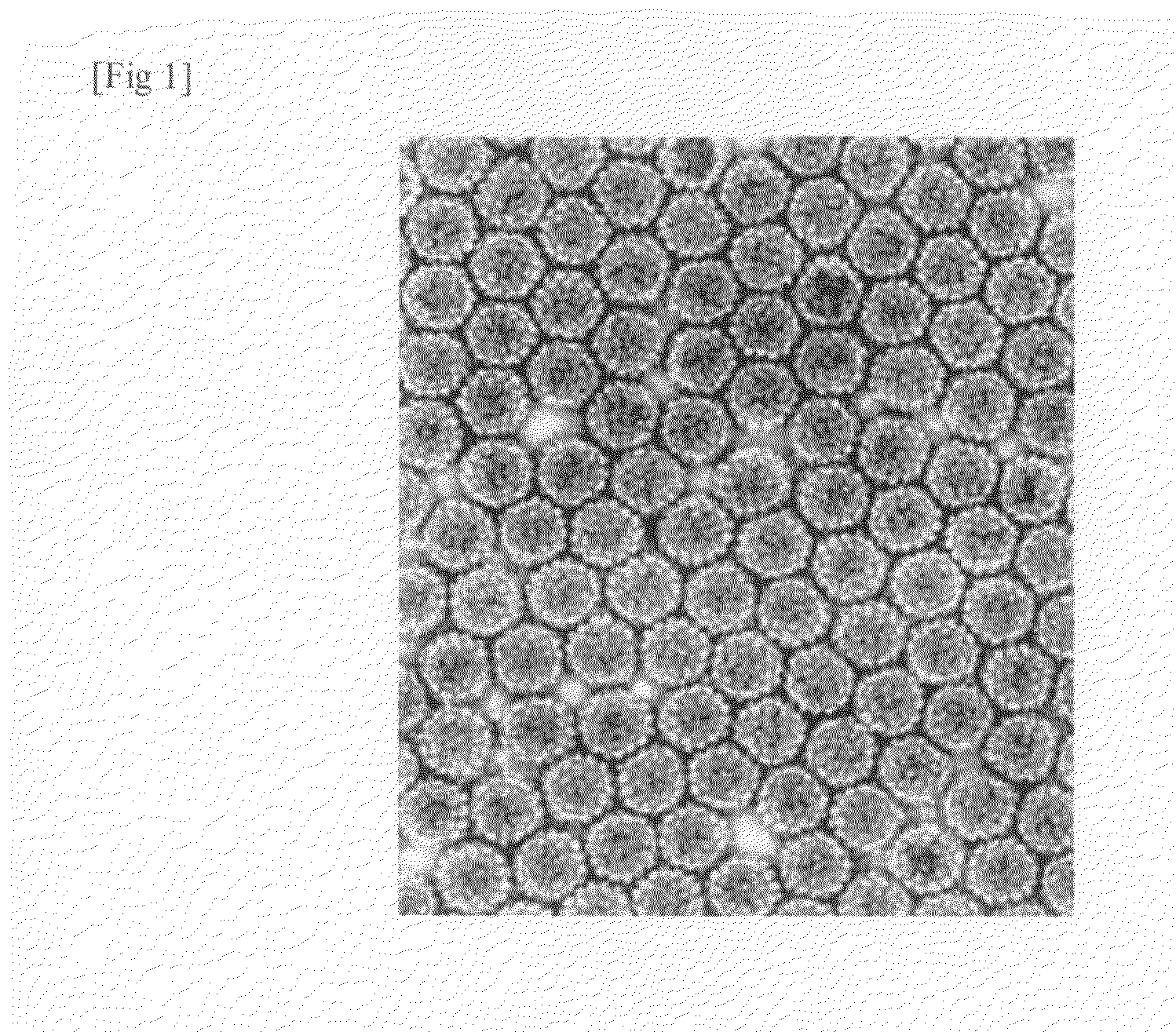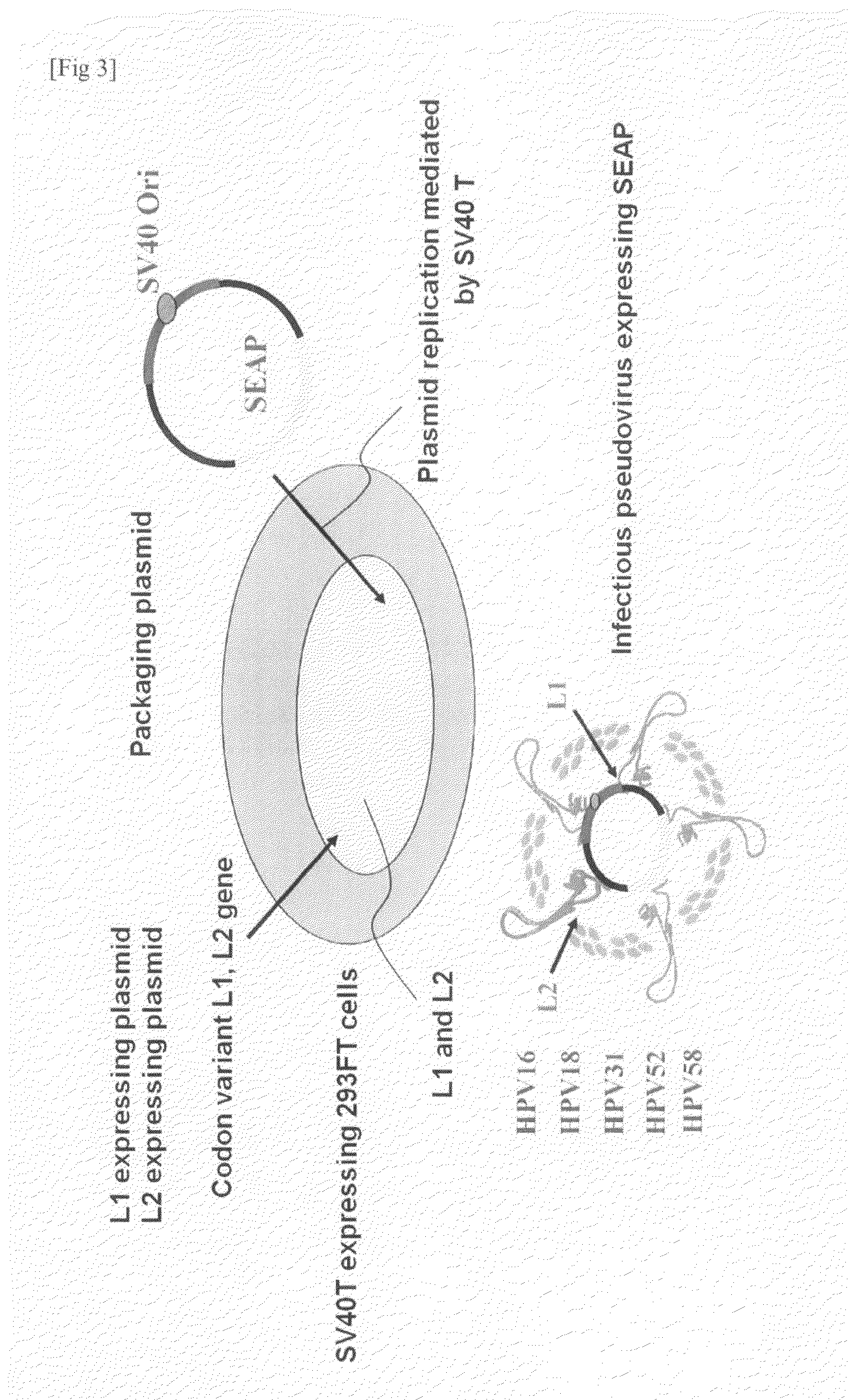Vaccine antigen capable of inducing cross-reacting and neutralizing antibody againts high-risk-type human papillomavirus
a human papillomavirus and antigen technology, applied in the field of chimeric proteins, can solve the problems of difficult preparation of practical vaccine antigens, no cultured cell lines allowing hpv proliferation, and almost ineffective in preventing other hpv genotypes, and achieve strong immunoinducing activity.
- Summary
- Abstract
- Description
- Claims
- Application Information
AI Technical Summary
Benefits of technology
Problems solved by technology
Method used
Image
Examples
example 1
Preparation of Rabbit Peptide Antisera
[0066]Two Japanese white rabbits (2.5 kg to 3.0 kg) were immunized. The antigen used was a conjugate of a chemically prepared peptide and KLH (keyhole limpet hemocyanin). In the first sensitization, 0.5 mg of the antigen was administered subcutaneously with complete Freund's adjuvant. After two weeks from the first administration, 0.25 mg of the antigen was administered subcutaneously with the complete Freund's adjuvant. The rabbits were sensitized similarly (0.25 mg) additionally after 2, 4, and 6 weeks, cumulatively five times. After one week from the final sensitization, the total blood was collected, to give a serum sample. (The preparation was performed by Scrum Inc. under contract.)
[0067]A rabbit was immunized with a synthetic peptide having the amino acid sequence of the HPV16 L2 surface region and the resulting antiserum was analyzed in the neutralization experiment shown below. Results are summarized in Table 1. The results shown in Tab...
example 2
Preparative Method of Capsid Antigen
[0069]16 L1 and 16L1 / L2 genes were expressed in a recombinant baculovirus system. A recombinant virus was prepared in a Bac-to-Bac baculovirus expression system (GIBCO-BRL Inc., New York, N.Y.), and expressed in Sf9 cells (Mamestra brassicae-derived cells). The 16L1 gene was cloned into pFastbac1 vector, to give pFastbac1 / 16L1. The 16L1 / L2 gene was cloned into pFastbac dual vector, to give pFastbac dual / 16L1 / L2. Then, each cloned pFastbac vector was introduced into DH10BAC E. coli (Max efficiency competent cell containing baculovirus DNA and helper plasmid, GIBCO BRL), to give Bacmid. The Bacmid DNA was introduced into the sf-9 cells by using an Effectene Transfection Reagent (QIAGEN GmbH, Hilden, Germany), to give a capsid protein-expressing recombinant baculovirus.
[0070]The recombinant baculovirus was infected to sf-9 cells, and the cells were collected after incubation for 72 hours. The infected cells were suspended in 0.5% NP40 solution; the m...
example 3
Preparation of Infectious Pseudovirus
[0075]1. An HPV16 L1 protein-expressing plasmid, an HPV16 L2 protein-expressing plasmid, and a secretory alkali phosphatase-expressing plasmid were transfected to 293TT cells by using Fugene HD. The cells were collected 72 hours after transfection.
2. The collected cells were suspended in a detergent buffer (0.5% Briji58, 0.5% Benzonase and 1% ATP-dependent plasmid safe exonuclease C in D-PBS (CaCl2: 1 mM, MgCl2: 10 mM)) and the suspension was left still at 37° C. overnight.
3. Then, the suspension was left still at 4° C. for 10 minutes, and 5 M NaCl was added thereto to a final NaCl concentration of 850 mM.
4. The cell suspension was centrifuged at 1,500g for 10 minutes, and the supernatant was collected.
5. The collected supernatant was layered on Optiprep (manufactured by AXIS-SHIELD PoC AS) solution at 27%, 33%, or 39% (diluted with PBS), and the solution was ultracentrifuged at 50,000 rpm for 3 hours at 16° C.
6. After ultracentrifugation, each f...
PUM
 Login to View More
Login to View More Abstract
Description
Claims
Application Information
 Login to View More
Login to View More - R&D
- Intellectual Property
- Life Sciences
- Materials
- Tech Scout
- Unparalleled Data Quality
- Higher Quality Content
- 60% Fewer Hallucinations
Browse by: Latest US Patents, China's latest patents, Technical Efficacy Thesaurus, Application Domain, Technology Topic, Popular Technical Reports.
© 2025 PatSnap. All rights reserved.Legal|Privacy policy|Modern Slavery Act Transparency Statement|Sitemap|About US| Contact US: help@patsnap.com



